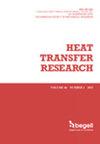Modeling the Influence of Nanoparticles and Gyrotactic Microorganisms on Natural Convection in a Heated Square Cavity: A New Machine-Learning Study
IF 1.6
4区 工程技术
Q3 THERMODYNAMICS
引用次数: 0
Abstract
The phenomenon of natural convection, which is widely used in nature and engineering applications, is a current issue that can be encountered in every field of daily life. In this study, the natural convection characteristics of a complex liquid containing nanoparticles and gyrotactic microorganisms in a heated square cavity were investigated using a machine learning approach. Nusselt number, average Sherwood number of nanoparticles and average Sherwood number of microorganisms were considered as natural convection parameters and an artificial neural network model was developed to estimate these values. Lewis number, Brownian motion parameter, thermophoresis parameter and buoyancy ratio parameter values were defined as input parameters in the network model, which has a multi-layer perceptron architecture developed with a total of 24 data sets. There were 10 neurons in the hidden layer of the network model, which has a Bayesian regularization training algorithm. The outputs obtained from the network model were compared with the target values, in addition, the prediction performance of the model was extensively analyzed using various performance parameters. It was seen that the predicted values obtained from the neural network and the target values were in an ideal harmony. On the other hand, the coefficient of determination value for the network model was 0.99999% and the mean deviation rates were lower than -0.03%. The results of the study showed that the developed neural network model can predict the natural convection parameters discussed with high accuracy.模拟纳米颗粒和陀螺状微生物对加热方腔中自然对流的影响:一项新的机器学习研究
自然对流现象广泛应用于自然界和工程领域,是当前日常生活各个领域都可能遇到的问题。本研究采用机器学习方法研究了含有纳米颗粒和陀螺微生物的复杂液体在加热方形空腔中的自然对流特性。纳赛尔数、纳米颗粒的平均舍伍德数和微生物的平均舍伍德数被视为自然对流参数,并开发了一个人工神经网络模型来估计这些值。路易斯数、布朗运动参数、热泳参数和浮力比参数值被定义为网络模型的输入参数。网络模型的隐层有 10 个神经元,采用贝叶斯正则化训练算法。网络模型的输出结果与目标值进行了比较,此外,还使用各种性能参数对模型的预测性能进行了广泛分析。结果表明,从神经网络获得的预测值与目标值非常协调。另一方面,网络模型的决定系数值为 0.99999%,平均偏差率低于-0.03%。研究结果表明,所开发的神经网络模型能够高精度地预测所讨论的自然对流参数。
本文章由计算机程序翻译,如有差异,请以英文原文为准。
求助全文
约1分钟内获得全文
求助全文
来源期刊

Heat Transfer Research
工程技术-热力学
CiteScore
3.10
自引率
23.50%
发文量
102
审稿时长
13.2 months
期刊介绍:
Heat Transfer Research (ISSN1064-2285) presents archived theoretical, applied, and experimental papers selected globally. Selected papers from technical conference proceedings and academic laboratory reports are also published. Papers are selected and reviewed by a group of expert associate editors, guided by a distinguished advisory board, and represent the best of current work in the field. Heat Transfer Research is published under an exclusive license to Begell House, Inc., in full compliance with the International Copyright Convention. Subjects covered in Heat Transfer Research encompass the entire field of heat transfer and relevant areas of fluid dynamics, including conduction, convection and radiation, phase change phenomena including boiling and solidification, heat exchanger design and testing, heat transfer in nuclear reactors, mass transfer, geothermal heat recovery, multi-scale heat transfer, heat and mass transfer in alternative energy systems, and thermophysical properties of materials.
 求助内容:
求助内容: 应助结果提醒方式:
应助结果提醒方式:


